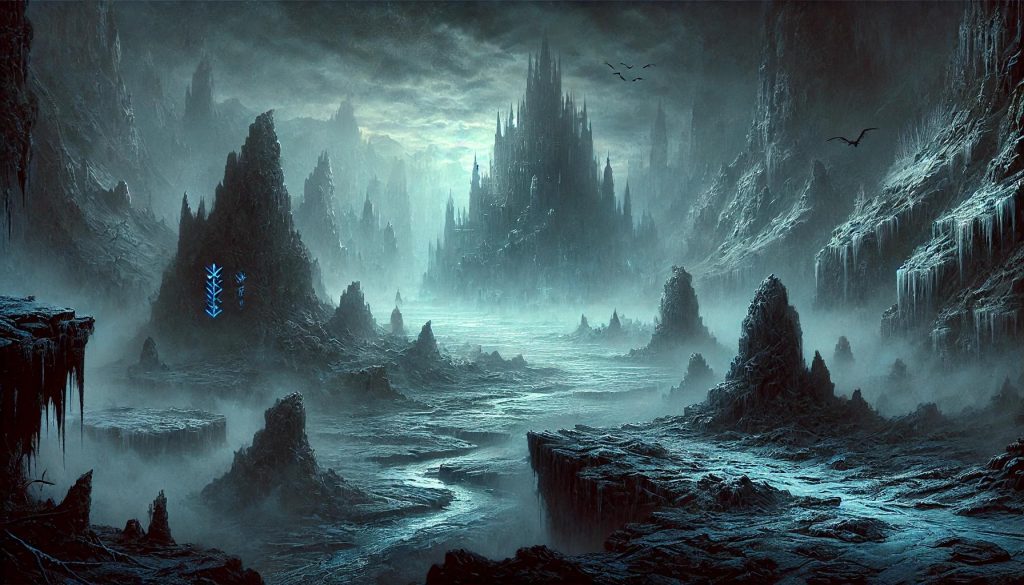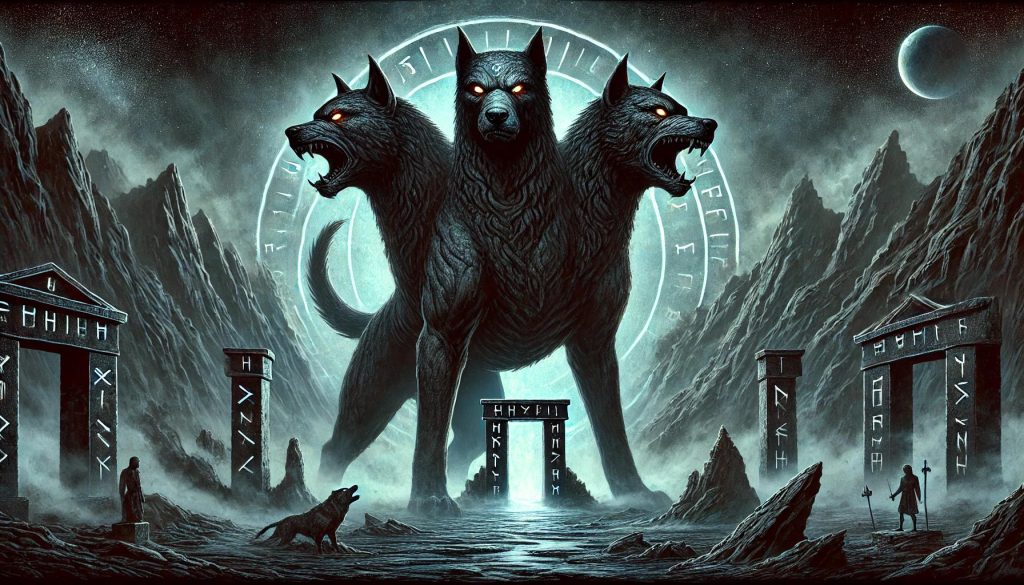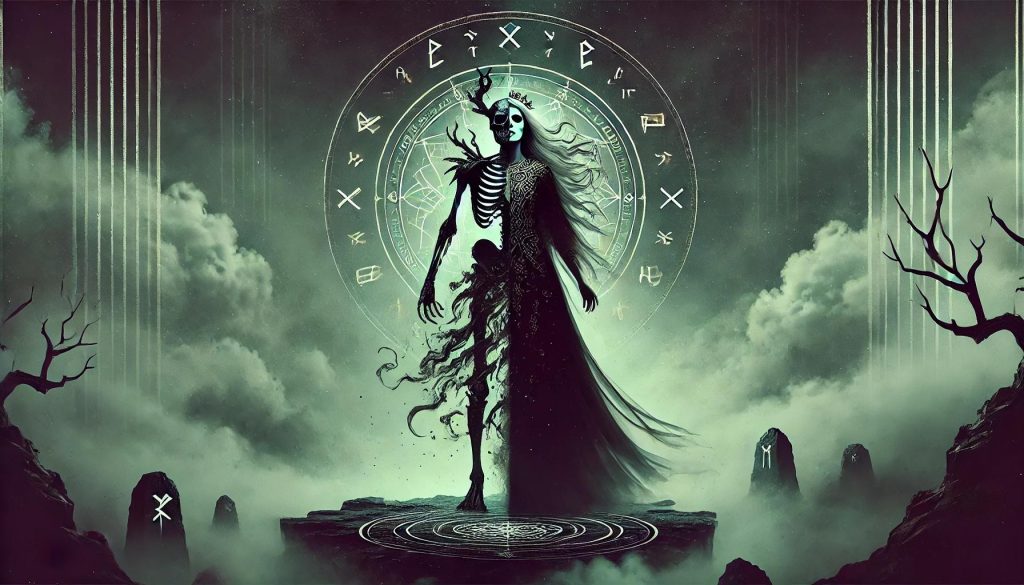Garm, Hel, Hel (The Underworld), Norse Goddesses, Norse Mythology, Norse Symbols, The Nine Worlds
The Symbols of Hel: Decoding Norse Mythology’s Dark Goddess
Hel is a key figure in Norse mythology, often overlooked but very important. She is the goddess of death and rules the underworld. Her stories are found in many myths, particularly those that explore the themes of Niflheim and the afterlife.
Hel has a special role, balancing life and death. She watches over those who have died. The symbols of Hel, the Norse goddess of death, show her unique qualities and beliefs about life after death.
Learning about symbols of Hel Norse mythology helps us better understand Hel’s role and opens up the world of Norse deities. This article will explore these symbols and their meanings in Norse cosmology.
Introduction to Hel in Norse Mythology
The goddess Hel is a key figure in Norse mythology. As the underworld queen, she represents the complex world of death and the afterlife, ruling over those who have died from illness or old age.
Her domain, Helheim, is a place of shadows and silence. It’s very different from the hero’s afterlife in Valhalla.
Hel’s family ties connect her to important gods like Loki and Odin, making her even more important in Norse stories. Death is a big part of Norse culture, showing their respect for the afterlife.
Hel’s role makes people think about the balance between life and death, which shaped stories about death in the Viking Age.
- Goddess Hel represents a unique approach to death and the afterlife.
- As the underworld queen, she governs those who pass away from illness or age.
- Her connections to Loki and Odin reveal deeper lore in Norse mythology.
- Understanding Hel enriches the study of ancient Norse beliefs about mortality.
The Origins and Mythological Background of Hel
In Norse cosmology, Hel is the goddess of the underworld. She is the daughter of Loki, the trickster god, and Angrboda, a giantess. Her origins show a mix of life and death, making her a key figure in Norse mythology.
In the Poetic Edda, we learn about her family. Being Loki’s daughter means she’s tied to big events like Ragnarok, especially in the context of the Norse pantheon. Her siblings, Fenrir and Jormungandr, also have important roles. This shows the Norse fear of death and its monsters.
Hel is respected and feared, often depicted as a powerful figure in the Norse tradition. Her story shows that death is not just the end. It’s a balance to life, showing the deep connection between the living and the dead in Norse culture.
Hel: The Daughter of Loki
Hel is a key figure in Norse mythology, being Loki’s daughter. This makes her very important in the Norse world. She has a special bond with her half-siblings, like Fenrir and Jormungandr.
These relationships help shape Hel’s character, particularly her ties to Loki and the giantess. They also affect her place among the gods.
Exploring Hel’s Parentage and Its Significance
Hel comes from Loki, which makes her special. Loki is known for causing trouble, but Hel balances life and death. Her family history shows how her father’s actions impact the world.
As a goddess of the dead, Hel has big responsibilities. This shows how her family background influences her role as the Norse goddess of death.
Connection to Other Norse Deities
Hel interacts with other gods in interesting ways. She contrasts with Odin, who values bravery, while Hel is often seen as a symbol of acceptance of death. Odin knows about life and death, while Hel rules over the dead in Helheim.
This shows how family ties shape a Norse goddess’s role, especially about Yggdrasil. Hel’s family background makes her very important among the Norse gods.
Hel’s Role as the Goddess of the Underworld
In Norse mythology, Hel is in charge of the underworld, called Helheim. This place is special in Norse stories. It’s where souls go after they die, especially those who didn’t die in battle.

Hel’s power in Helheim is key in Norse stories. As she governs Hel’s realm, she demonstrates her authority over the realm of the dead, which shows her importance in understanding life and death.
The Concept of Helheim in Norse Cosmology
Helheim is more than just a graveyard. It’s a place where the dead still exist, a place to think about death and accept it.
It’s not seen as a punishment. Souls find a home here, showing a different view of death in Norse culture.
Comparison with Other Underworlds in Mythology
Helheim differs from other underworlds in myths, reflecting unique aspects of the Norse gods and goddesses. For example, Hades in Greek myths is seen as harsher. Souls face judgment and possible suffering there.
But Helheim is about acceptance and little judgment. This shows how different cultures see death and what comes after.
Hel Norse Mythology Symbols
Exploring Hel symbols Norse mythology shows us much about life, death, and what comes after. Hel, the goddess of the underworld, has symbols that show her importance in Norse stories, particularly in her role within the Norse pantheon. These symbols help us understand Norse mythology and its cultural value.
Key Symbols Associated with Hel
Many symbols in Norse mythology tell us about Hel. Some important ones are:
- Garm: This three-headed hound guards the entrance to Helheim, symbolizing the boundary between life and death.
- Mist: The pervasive fog in her domain represents uncertainty and the unknown aspects of the afterlife.
- Crow: Crows are often associated with death and transformation as messengers between the living and the dead.
The Meaning Behind Each Symbol
The meanings of these symbols go deeper than they seem. Garm shows Hel’s protective side, meaning death is scary and safe. The mist around Helheim reminds us of the mysteries of death. The crow connects life, mythology, and what comes next.

These symbols are key in Norse culture, showing how people view death and the afterlife, especially concerning Hela. They highlight our complex feelings about dying and what happens next. Even today, these symbols help us understand our views on death and beyond.
The Dual Nature of Hel
Hel has a deep dual nature. She shows both the end of life and the start of new life, reflecting the cycle of rot and renewal. This makes her very complex in Old Norse stories.
She’s not just a goddess of death; she’s a key part of the cycle of life and death.
Life and Death: Balancing Forces
Hel’s stories always discuss life and death. She shows that death is part of life, not just the end, which changes how we see death in Norse myths.
Hel is more than just a door to the afterlife. She protects life’s cycle, too.
Hel’s Depiction in Old Norse Literature
In Old Norse stories, Hel is shown in many ways. She’s seen as kind, not just scary, which is a common misconception about the Norse goddess of death. The Sagas show her as a guardian, balancing life and death.
Her caring side means she helps souls move to the afterlife safely. This shows her big role in Norse myths.
Mythological Events Involving Hel
Norse myths tell us about Hel’s big role in the myth world. The story of Baldr shows her power and the importance of life and death. Her actions in this story show her character and role as a guardian of the dead.
The Story of Baldr and Hel’s Role
Baldr’s death is a key moment in Norse myths, highlighting Hel’s role in the realm of the dead. He was destined to die young, and the gods tried to stop it. But Loki’s trick led to Baldr’s death, and Hel took his soul.
The gods asked Hel to bring Baldr back. But Hel said Baldr could return only if everyone truly mourned him. This shows Hel’s role as a guardian and the importance of remembering and mourning.
The Army of the Dead and Hel’s Guardianship
Hel also leads the army of the dead, showing her power in the underworld. Her place is shadowy for those who didn’t die in battle, but her leadership is respected, balancing the living and the dead.
These stories make Hel a key figure in Norse myths. She shows the complex ties between life, death, and the afterlife.
How Hel is Represented in Art and Culture
Hel’s art shows her as a figure of death and a symbol of change. Artists and writers have shown her in many ways, reflecting how people see death and the afterlife.
In old times, Hel was seen as scary in art. This showed her role in Norse myths.
Cultural views shape how Hel is shown, influencing perceptions of her role as Loki’s daughter and the ruler of Hel’s realm. As the underworld’s guardian, Hel shows death’s inevitability, but this has changed over time.
In medieval times, Hel was seen as very scary. Now, she’s seen as more complex. This shows how views on death have changed.
- Visual Art: Paintings and sculptures show Hel in many ways. She’s been seen as scary and more human-like.
- Literature: Hel’s character has grown in stories, often depicting her as a nuanced figure in Norse tradition. She shows themes of loss, grief, and power.
- Modern Pop Culture: Films, TV shows, and games have made Hel their own. They add to her story of Hela and her significance in Germanic mythology.
These new views of Hel help us see her in a new light. They show how Hel’s story is still important today, reminding us of the inevitability of death and the underworld. It makes us think about life, death, and what it means to be human, especially in the context of Yggdrasil and the cycles of existence.
The Legacy of Hel in Modern Interpretations
Hel’s influence is still felt today, shaping many parts of our culture. Her legacy shows how old myths live on in new stories that explore life, death, and the mysteries of being alive.
Influence on Popular Culture
Hel’s story has made its mark in books, movies, and TV shows. Characters inspired by her often show two sides of life, mirroring the duality present in Hel’s appearance. They help us think about the balance between life and death.
Big names like Marvel have brought Hel into today’s pop culture. They’ve made her story more interesting, especially through her connections to Loki and the giantess.
Academic Perspectives on Hel
Experts are still studying Hel, linking old myths to today’s world, particularly her role as the goddess of the realm of the dead. They look at her symbols and what they mean now. This helps us understand our views on death and who we are.
Conclusion
In our look at Hel in Norse mythology, we’ve seen her complex side. She’s the goddess of the underworld. Her story shows her as Loki’s daughter, ruler of Helheim, and full of symbolism.
Her impact goes beyond old stories. Today, Hel’s story is still loved by many. It shows how life and death are connected, a theme that lasts forever.
Hel makes us think about death and what comes after. She shows us the balance and morality of Norse culture, embodying themes found in Norse tradition. Her tale is a deep look at life’s end and the following mystery.

